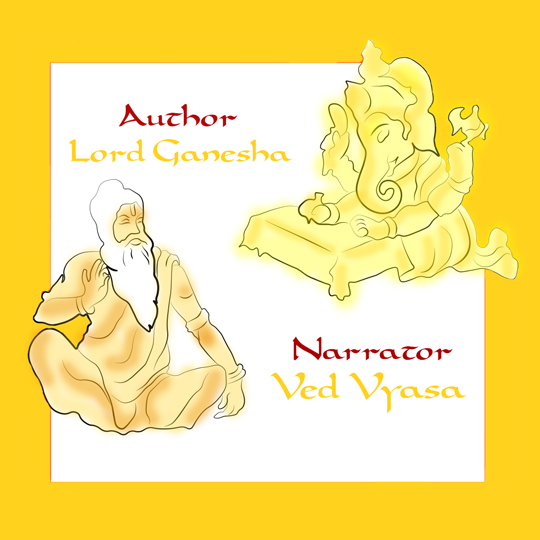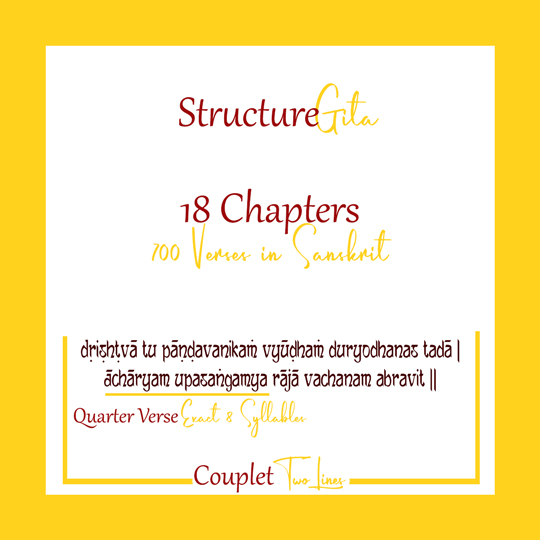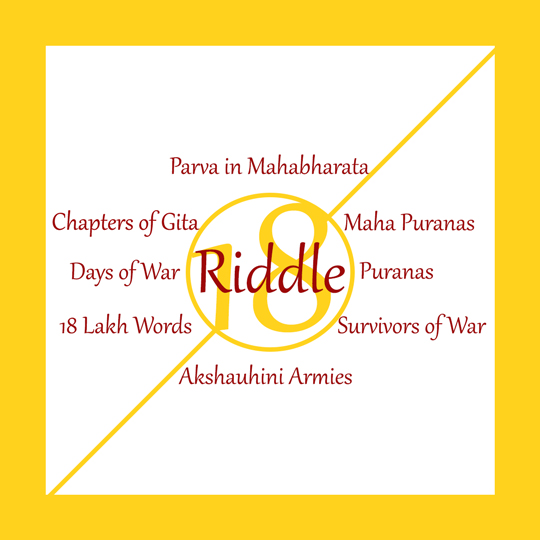Bhagavad Gita – Why A Theistic Science

Nomenclature & Authorship of Bhagavad Gita
Gita Means Song. The word Bhagavad can be interpreted in many ways giving various meanings to the title, such as –
- the word of God
- the words of the Lord
- the Divine Song
- the Celestial Song
In a common tradition, Bhagavad Gita is attributed to Krishna Dvaipayana or Ved Vyas, who recited it to Lord Ganesha, who sat down to write.
However, evidence suggests that it is impossible to link Gita to one author. It may be the work of many authors.
Also, regarding Gita as an independent text which somehow wandered into the epic Mahabharata will be wrong. Instead, it was conceived by Mahabharata Authors to bring a climax to the dharmic dilemma of war.

Significance of Bhagavad Gita
Bhagavad Gita incorporates various religious traditions, and its synthesis is at both philosophical and socio-religious levels. The text refrains from establishing one right path to spirituality and accepts multiple ways of life, thereby making spiritual pursuits possible through –
- Action (Karma)
- Knowledge (Gyana)
- Devotion (Bhakti)
Bhagavad Gita addresses the question of the path necessary for spiritual liberation (moksha). Whether to,
- Renounce a householder lifestyle for a life as an ascetic. (Enlightenment-based renunciation).
- Or lead a householder life dedicated to one’s duty and profession (Dharma-based householder life).
- Or pursue a householder life devoted to a personalized God (Devotion-based Theism)

Manuscript & Structure of Bhagavad Gita
The Bhagavad Gita manuscript is found in the sixth book of the Mahabharata Manuscripts – the Bhisma-Parva.
In the third section, the Gita forms chapters 23-40, 6.3.23 to 6.3.40.
However, Bhagavad Gita is often preserved and studied on its own as an independent text, with its chapters renumbered from 1 to 18.
Written in Sanskrit, the Bhagavad Gita consists of 700 verses or Shlokas.
It has 18 Chapters in total.
Each shloka consists of a couplet, making the entire text 1400 lines.
Each shloka line has two-quarter verses with exactly eight syllables.
These quarters are further arranged into “two metrical feet of four syllables each.”

The Riddle of Number 18
Although, there are a lot of facts about Mahabharata which forces us to think twice before we can even question the reality of the Epic. But the most interesting thing about it is the predominant presence of the number 18.
- 18 Chapters in Bhagavad Gita
- 18 Parvas in Mahabharata
- 18 Maha Puranas
- 18 Puranas written by Ved Vyasa
- 18 Days Mahabharata War lasted for
- 18 Akshauhini Armies fought in the war
- 18 Warriors survived the war
- Lord Krishna killed Kansa at the age of 18
- 18 Times Jarasand attacked the Yadavas
- For 18 years Jarasand attacked them
- An Akshauhini Army consists of – 21870 Chariots, 21870 Elephants, 65610 Horses and 109350 Soldiers. The digits of each add upto 18.
- Bhishma survived the war for 9 days (Half of 18)
- Pandavas ruled Hastinapur for 36 years (Double of 18)
- Mahabharata Epic is written in 18 Lakh Words
- The original name given to Mahabharata by Vyasa was Jaya (Victory), the numerical value of the Sanskrit word Jaya is 18
- Mahabharata was written by Lord Ganesha who is often associated with the number 9 (Half of 18) symbolizing the shape of his Trunk
Possible Logic
Out of all the base natural number (1,2,3,……………….9), Number-9 is the culmination of the calculation, other numbers are just a combination of these base numbers. This gives highest value and place to number 9.
Summation of the digits of all the factors of 9 (18, 27… etc.) always results in 9.
Therefore, making 9, the number of spirituality, indestructible like Soul.
Nothing can be higher than this, the rest is just Permutation & Combination.
As said in Mahabharata, “Na aisa yudh hua hai, na kabhi hoga.” (Neither such kind of war was fought in the past nor it will be fought in future)
Hence, Mahabharata is considered as culmination of everything – spirituality, economics, war-skills, science & technology, politics, love, hatred, family matters etc.
Why is Bhagavad Gita, a Theistic Science?
When we hear the word Science, our brains are trained to think of it as the Universal Truth. (And we believe it because there is the so-called “proof” to it.)
Instead, when we hear, Religion, different brains think of Multiple Definitions. (With or without significant proof, usually the latter.)
All the other scriptures, be it Mahabharata, Ramayana, or Vedas, were written on the understanding of sages (though learned, yet humans), while Gita is what was spoken directly by the Supreme Personality of the Godhead.
All the other scriptures lay before us things to be done and the items to be forsaken, but through Gita, God just lay before us what is right and wrong, but the choice is always ours to make.
Proof –
Science is beyond humans, religions, and even time. It’s the Universal Truth, and so is Bhagavad Gita.
In Chapter-4, Shloka 1 & 2, Lord Krishna talks about passing on this eternal Science to the Sun God, who gave it to Manu (the father of mankind) and those who followed after but with time, it was lost into the world.
Hence, Krishna recited it again 5000 years ago on the battlefield of Kurukshetra for the welfare of mankind.
Now consider the following timeline –
3300 BCE – Indus Valley Civilization Began
3120 BCE – Mahabharata War took place
1500 BCE – The Early Vedic Period Began (Vedas were written down in Sanskrit, and at the same time, Hinduism was born out of the ReligionReligion brought by the Aryans)
700 BCE – Hindu Caste System Emerges
400 BCE – Mahabharata and Ramayana were composed.
Gita is beyond humans because it is the Word of God.
But it is also beyond time and Religion if one carefully studies the timeline.
This Eternal Science was there even before the birth of man. It was there even before our Religion began, and it will be there even after we all perish.
Recitation & Narration of Bhagavad Gita
The theistic science was recited by Lord Krishna exclusively to Arjuna, but who else got to listen to it?
Sanjaya (Dhritrashtra’s Advisor and Charioteer), due to Divine Vision (Divya Drishti) granted by Sage Vyasa, could see and listen to all the happenings of the war.
Lord Hanuman was seated on the flag of Arjuna’s chariot.
Some versions mention Barbarika, the son of Gathotkach, but it is not there in the Bharata of Vyasa.
How long did it take Krishna to recite the Gita?
The minimum time for reciting 700 Shlokas should be 45 minutes at a particular pace.
However, the fact that two armies assembled on the battlefield would wait for the whole conversation seems absurd.
Did Krishna stop time then, as many claims?
Although Lord Krishna is beyond time and space, he did not stop time, nor it can be controlled.
Then what could be the possible explanation for it,
“How it was even possible to recite it completely within a few seconds?”
Time is Linear yet Relative. Krishna spoke to Arjuna’s higher consciousness. (Beyond conscious, sub-conscious, and unconscious)
Krishna is not bound to life, death, time, or space. In his higher consciousness, time doesn’t exist as it does for us.
He exists in the 4th state of Yogic Consciousness.
(Which transcends above all the primary three states.)
Making time relative. (We experience the same thing while dreaming, even sleep of 15 minutes can show us dreams of a lifetime.)
How did then humanity come to know about Gita?
If Gita was a conversation between Krishna and Arjuna, why do we find it written in the Third Person?
Its because the version of the Gita we see is written from the viewpoint of Sanjaya.
Interpreting Bhagavad Gita in Modern Era
Human Civilization has existed for thousands of years and will continue to do so. With logical reasoning, science and mathematics, we succeeded in developing technology, the wonders of which are no less than any mythological tales of old.
We went after Methodological Naturalism and put Theistic Realism far behind us, the Homo-Sapiens of the 21st Century.
Now, Methodological Naturalism is a strategy adopted by scientists to study the world without considering any Supernatural Causes. Usually, two assumptions are taken –
First – God doesn’t exist, and there is no life after death.
Second – God may exist, but any supernatural action would be arbitrary and hinder systematic study.
Theistic Realism is a philosophy based on the belief that God exists, acts in the Universe, and is knowable through senses.
Why even consider it?
Now, observing the physical Universe, we cannot overlook the fact that there must be a non-physical mind-like reality. Physical existence doesn’t explain itself. The Universe is a derivative of a deeper, ultimate reality.
Both aspects have been a topic of great debate among scientists and philosophers. Now the question arises,
Who is Right & Who is Wrong?
Well, that is not for me to decide.
I am an author; my job is to write.

One response to “Bhagavad Gita – Why a Theistic Science?”
Excellent commentary. The other day I found this site and wanted to let you know that I have been gratified, going through your posts. I will be signing up to your RSS feed and will wait for your next post.